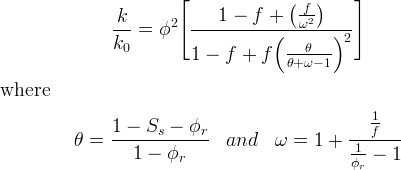STOMP User Guide
STOMP User Guide
Hydraulic Properties Card Options
The following material properties of the porous medium are specified in the Hydraulic Properties Card. Each property must be specified for each rock type defined in the Rock/Soil Zonation Card. The options available for each property are described under the correponding tab.
Permeability
This is the default specification. Permeability is computed as the product of the rock intrinsic permeability and the permeability reduction factor. A primary assumption of the simulator is that principal components of the intrinsic permeability tensor are aligned with the principal coordinate directions. For cylindrical coordinate systems the radial, azimuthal, and vertical permeabilities correspond with the x-, y-, and z-direction values, respectively. The permeability tensor in STOMP has zero off-diagonal elements, requiring the specification of intrinsic permeability in the three principal axis directions, but intrinsic permeabilities for inactive principal directions are not required. For example, in a one-dimensional radial problem, only the intrinsic permeability in the radial direction needs to be specified. Default units of m2 are applied to null entries for the units associated with permeability values.

The user may choose to include permeability reduction due to salt precipitation (Pruess and Garcia. 2002; Verma and Pruess, 1988). The permeability reduction model uses a tube-in-series model to represent permeability changes, requiring two additional inputs for pore-body fractional length and fractional critical porosity.

| Symbols | |
| k | intrinsic permeability, m2 |
| K | hydraulic conductivity, m/s |
| μ | dynamic viscosity of fluid, kg/(m•s) |
| ρ | density of fluid, kg/m3 |
| g | acceleration due to gravity, m/s2 |
| φ | porosity |
| φr | fraction of original porosity at which permeability goes to zero |
| f | fractional length of the pore body |
| k | reduced permeability |
| k0 | initial intrinsic permeability |
| Ss | Solid saturation |
If the Rock/Soil name is "IJK Indexing," "JKI Indexing," or "KIJ Indexing," then the value specified will be applied to all nodes in the domain. Alternately, any parameter value can be replaced with an external file.
If the key words 'dp,' 'dual porosity,' or 'fractured' appear in the rock/soil name specified inthe Rock/Soil Zonation Card, this indicates a dual continuum medium and the reading of both matrix and fracture properties (e.g., Fracture and Matrix Intrinsic Permeability) is triggered.
Hydraulic Conductivity
If units of hydraulic conductivity are specified, the intrinsic permeability is computed assuming that the hydraulic conductivity was specified for the density and viscosity of water at 25˚C and 1 atm.
If the key words 'dp,' 'dual porosity,' or 'fractured' appear in the rock/soil name specified inthe Rock/Soil Zonation Card, this indicates a dual continuum medium and the reading of both matrix and fracture properties (e.g., Fracture and Matrix Hydraulic Conductivity) is triggered.